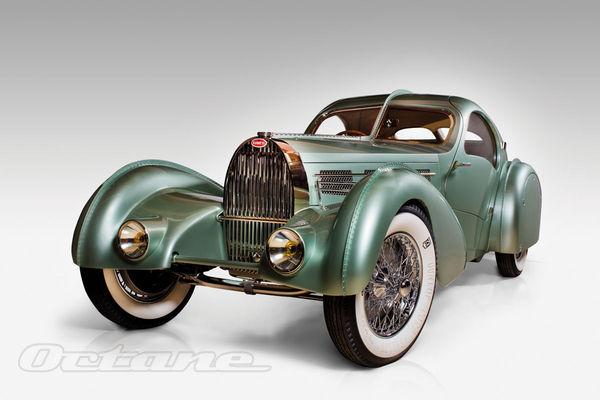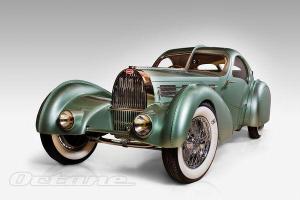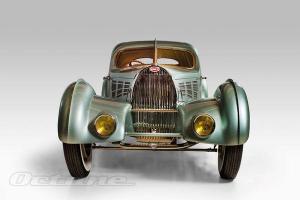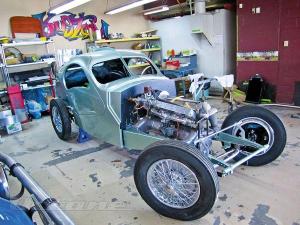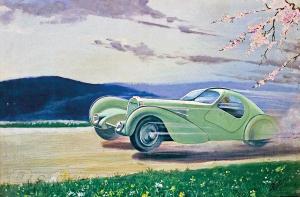The first time I was asked to build a Bugatti I said: 'Sure - it's just a car, how hard can it be?'
That turned out to be one of the most stupid things I have ever said. The Bugatti was a Type 59 3.3-liter Grand Prix car and I had little more than half the original parts. It proved to be quite an education, not only in the complexity, elegance and sometimes stupidity of Bugatti engineering, but in the politics of highly valued cars too. That project took about three years and the result was agonizingly beautiful. It was also the bane of my existence.
With the Type 59 GP parts came an original Type 57 chassis with the correct engine, transmission, rear axle and most of the original mechanical components. The only major component missing was the front axle, although the axle stubs, brakes, steering and suspension parts were in place.
The chassis turned out to be pretty special on its own: chassis no 57104, the fourth Type 57 produced, appears to be the oldest still in existence. I have heard rumors that an earlier chassis is still out there but I have not yet been able to find it, or even documentation to support the rumors.
Chassis 57104 was originally delivered to Lamberjack, a Parisian dealership, in 1934. It was probably bodied as a drophead by Van Vooren and then went through a string of owners. It appears to have lost its coachwork during the Second World War or shortly after and a replacement body was never mounted but the chassis and mechanicals remained a cohesive flock of parts.
Post-war and without coachwork it went through another string of owners and was eventually purchased by Tom Barrett, co-founder of the Barrett-Jackson auction house. He wanted to put an Atlantic body on it and to that end it was sent to Bugatti restorer Ray Jones. Jones replaced 57104 with an SC chassis replica which was correct for the Atlantic; the standard 57104 chassis was deemed surplus. I acquired it in the mid-1990s and was tempted to restore it as a fully running chassis, but then what do you do with it?
I began poring through books for inspiration. My focus had been on racing cars but my heart found a home as I became aware of some of the dramatic Bugatti road cars produced during the 1930s. One page became increasingly dog-eared. I kept straying back to pictures of Jean Bugatti's masterpiece, the Aerolithe.
My original partner on the Type 59 had no interest in building another Bugatti (he used to say some very uncomplimentary things about Bugattis, usually while he was signing another check) so I tendered the project. I had numerous replies and some very serious interest, including a certain Nicolas Cage of California. Despite his own best intentions a couple of years went by and nothing happened, and then I got a phone call from another gentleman who was interested in the project.
Not a Hollywood A-lister this time, nor a car buff. He was, however, an art aficionado with strong ties to the world of architectural restoration, and was familiar with how inexact that science can be. His greatest passions extended to the saving and preservation of historical monuments and buildings around the world, a passion that still seems in no danger of abating.
He was perhaps the best possible patron for this task. He wanted us scrupulously to adhere to the crafts and methods of the 1930s and for the star of the 1935 Paris auto show car to be recreated with no modern liberties taken. Our shared vision ensured that we would be as faithful to the original Aerolithe as it appeared on the Bugatti stand at the Palais Royale as was humanly possible. With those rules established we set about the task of building the crown jewel of Bugatti's 1935 salon collection.
Very little of the enormous research involved centred on the Aerolithe itself. There are only about 11 meaningful photographs of the car and no specifically Aerolithe blueprints or plans, aside from that of the radiator and another of a foot pedal. These, according to the Bugatti Trust at the time, were all that survived. What writings exist are sketchy, many are contradictory, and some older essays have been the subject of prejudicial editing over time, especially in the last decade or so.
One thing we did know. When Ettore Bugatti came under fire from critics for the spinelike fins that ran along the wings and centerline of the car, he stated that the coachwork had been made from a new wonder metal called Elektron. As it could not be welded, the fins allowed the major sections to be riveted together. Elektron is a magnesium alloy consisting of around 97% magnesium, with the remainder aluminium. The press dubbed the car the Elektron Coupe.
It was decided even before the project started that to create the Aerolithe coachwork in anything but magnesium would be inexcusable. That decision made life difficult and costly over the next six years.
Magnesium is hard and light: its only two redeeming qualities. It is also brittle, almost unbendable, and dangerously flammable. If that weren't enough our bodies absorb it in great quantities, which can lead to uncomfortable symptoms. The solution is to dress like a spaceman, especially when welding, heating or cutting it. The solutions to the other problems are a little more difficult.
When you bend it, if it doesn't crack it will soon be reassuming its original shape. When we first bought the 8ft by 4ft sheets we were told it could not be hand-formed or bent on the English wheel, especially into the tight compound curves we required. The manufacturers advised us to cast the shapes, but this was not an option; we had to find a way to shape it by hand.
We discovered that if we heated the material to around 850ºF it became plastic enough for us to shape on the wheel, but at around 1150ºF it starts to burn. Suffice it to say that specialized fire extinguishers were at hand.
Once an apprentice unfamiliar with the material thought he would help out by grabbing a burning bit before the welder could get his helmet off. With the sputtering magnesium part in hand he raced across the shop with my welder in hot pursuit, carrying the extinguisher and yelling at the top of his lungs. With a gasp of relief the apprentice hurled the flaming torch (moments before, it had been a headlight pot) into the sink and turned the water on full. The result was an odd explosion that saw the entire shop waist-deep in a seething cloud of magnesium fog followed by a mass exodus of all staff. It looked like a Hollywood horror film set. All employees were then trained fully in the vagaries of magnesium handling.
After months of trial and error the material was finally mastered and the build began in earnest. The chassis itself was so complete that it was a very easy process to restore it, even to the high level that I demanded of my staff. We knew that the Aerolithe's engine was a basic non-supercharged 3.3-liter straight-eight that, in order to allow for a lower hood profile, had been moved about 90mm rearwards from the standard position of the radiator hovering over the front axle. This meant the radiator and cowl could be positioned behind and lower than the front axle, something quite visible in pictures of the Paris show car. Apart from a need to create two new rear engine mounts the job was accomplished with no fuss. But then some discoveries put us in hot water with members of the old guard.
We told all concerned that we really did not care what the chassis of the original car was, as we were building the non-supercharged shortened-standard-chassis number 57104 and mounting Aerolithe-style coachwork on it. The actual Aerolithe became one of the great automotive mysteries after it disappeared sometime after a visit to England in 1936. I have always harbored the suspicion that, as an ageing and useless design prototype, it was probably torn down for its valuable mechanical bits and pieces at the factory, which was financially stressed at the time.
The common understanding, which I shared until I built the car, was that the Aerolithe, while not supercharged, sat on an S chassis, the one common to all three Atlantics for which the Aerolithe was the prototype. Some go so far as to maintain that the car was built on a T57 S gondola chassis, which curved to a point at the back. That chassis was built to accommodate a car that resembled a T59 GP car called the T57 Torpedo TT, which was being built at the same time. We checked this theory very closely, as its supporters were strident, and came to the conclusion that the coupe's body would not sit on a gondola chassis and allow space for the fuel tank and spare tire, nor would the steering box require the clearly photographed bulge in the coachwork that was dictated by a standard chassis. It would have also needed some very odd outriggers to support the coachwork at the rear, which were totally impractical.
What we found was that a lot of armchair theories were not viable in the real world of building a car, either now or in 1935. In fact the Aerolithe coachwork sits very comfortably on a shortened standard chassis with virtually no modifications. An S chassis would have called for an unlikely amount of unnecessary engineering. The last coffin nail, I believe, is that the SC chassis was not developed until the Aerolithe was almost complete. It would have taken the coachbuilders months to wrangle the magnesium alloy into the Aerolithe and I am sure they would not have dismounted the exhibition coachwork to plonk it onto a brand new chassis that was not featured anywhere on the 1935 Paris Salon Bugatti stand.
The storm of controversy that these discoveries created was mystifying, as we were not trying to prove anything but rather just reporting what we were finding.
Another point of contention was our choice of color for the car. Along with everyone else I had always assumed that the car was silver. Mind you, in those days, silver was the German national racing color. Once, at a concours where I was displaying the T59, I spoke to an elderly Frenchman who had served his apprenticeship with Bugatti. We chatted through an interpreter and I told him my next project might be the Aerolithe recreation. He recalled sweeping up around the car and that it was codenamed Creme de Menthe.
A couple of years later I came across a 1936 painting by one of Bugatti's designers that was given to Jean Bugatti as a gift. In it the Aerolithe is represented flying down a springtime road surrounded by fields of flowers and blossoming trees. The color? A delightful green, like a mixed creme de menthe.
It would be hard to believe that the painter would present this painting to the car's creator in the wrong color, so I tested it by taking a photo of a bent spray-out and transferred it to black-and-white. It looks exactly like the color in those photos taken back in 1935.
A major feature of the Aerolithe and all the cars on the 1935 stand were the two-sided whitewall tires, unusual in Europe. We tried to find a set, as to create the car and not have the right tires on it would have driven me crazy. The only solution was to make them.
After a month's pursuit of Goodrich and Goodyear (who share the old Dunlop rights) we finally got permission to recreate the tires with the same markings, lettering and script. All the markings were created in white rubber for application on the tires; Goodyear had insisted that only vintage-style Dunlops be used, so we had to get the correct size and have the white area carved out on both sides so that the whitewall could be vulcanized and the markings and lettering then vulcanized in place. Recently I bought a Delahaye from Spain and it had one original series-90 Dunlop blackwall on it. When we compared our markings to the originals on the blackwall we were absolutely exact. It was quite an accomplishment for our project leader, who spent almost a year on the tires and did all the scaling and template cutting.
Now the project is winding down and the car's future is being mapped out. To my delight, the reception we're getting is absolutely wonderful. The car is one of the main stories in the first season of a major TV series being shot at my premises and we are entertaining requests to exhibit it from museums all over the world. It has been an idea, an obsession, a business proposition, a controversy, a headache, a constant irritant and finally a magnificent cooperative work of art that I have had the pleasure and honor of building with a team of gifted individuals.
I had no idea when I was staring at those grainy black-and-white photographs so many years ago that this day would be so long coming or, indeed, if it ever would. Looking back there is very little I would change; even the disasters were sort of fun and I love nothing better than a good fight. The car itself, I expect, will outlast me and, while I have my name on more than 1000 restorations so far, I think this is one I will remember as a high point.
The realization of what had been accomplished didn't sink in until recently. We were in the middle of a photo shoot with the Bugatti, and the photographer, who was also the director of the pilot for our TV series, walked around the car in some wonderment, then turned to me and said: 'You made this.'
Yeah, I guess I did.
Thanks to The Guild of Autmotive Restorers.
"Recreating The 1937 Bugatti Aerolithe." AutoTraderClassics.com. N.p., n.d. Web. 30 Mar. 2015.
